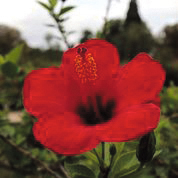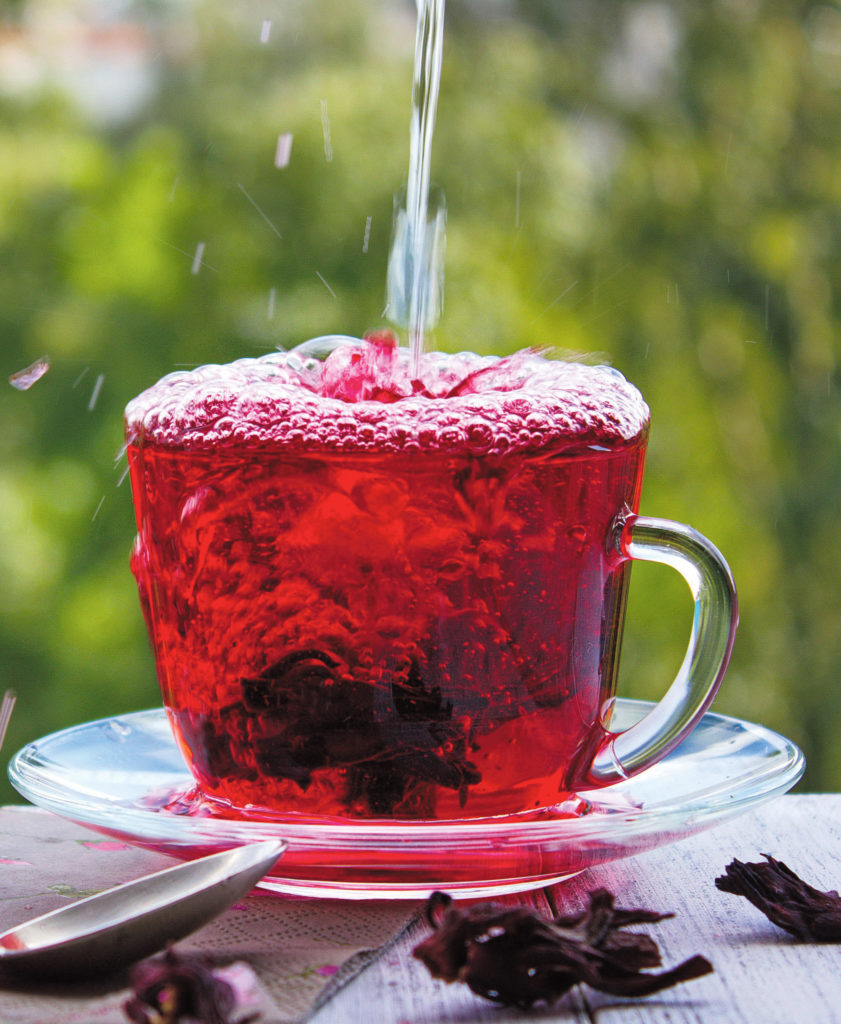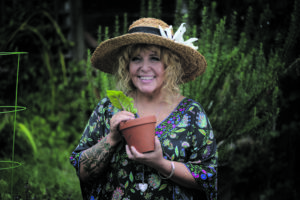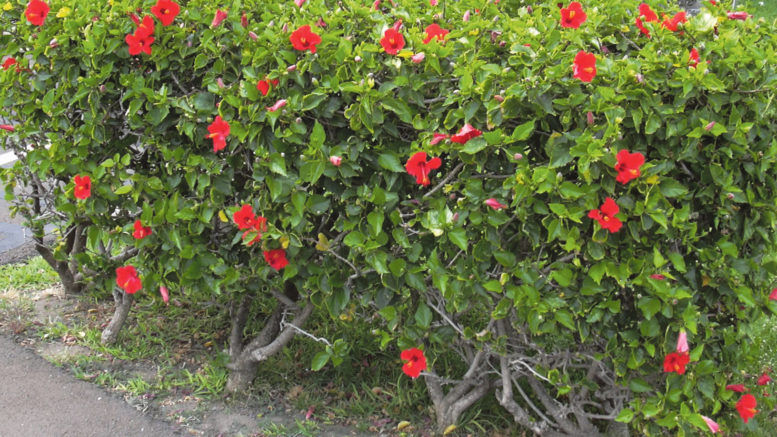As summer returns to the Coast, so do the hibiscus!
We have a bit of a love affair with this tropical looking blossom as any balmy evening walk through our suburbs will affirm.
Flowering time is early spring to the end of autumn, so they make a wonderful addition for summer-long colour.
I’ve noticed Coast gardens with hibiscus as high as their homes along with hedges of this plant that have obviously fenced yards for years.
Hibiscus History
Members of the Malvaceae family, the actual origin of the beautiful hibiscus is not really known.
The problem with botany is that we have naturalised plants throughout history as we have travelled, mixed cultures and then hybridised them to suit our needs.
These days there are over 300 species of Hibiscus.
They decorate Hawaiian shirts, are featured in every mid last century surf movie and if you like a beach house theme, you probably have something embellished with either a frangipani or a hibiscus.
The popular ‘garden hibiscus’ (Hibiscus rosa-sinensis) used in all this imagery however, probably came from China and then made its way to Japan and through to the Pacific Islands and beyond.
Hibiscus rosa-sinensis are also known by the common names of Chinese Hibiscus, China Rose, Hawaiian Hibiscus, Rose Mallow, Shoe Flower and Shoeblack Plant.
Growing Hibiscus
This easy to grow Garden Hibiscus will usually flower perennially and can attain a height of up to 10 metres in the wild in favourable conditions.
They can be planted and trained to become a gorgeous hedge and make a lovely standard shrub in a varying size depending on the cultivar.
Colours range from singular colours of whites, reds, yellows, oranges, pinks, purples, blues, browns and stunning multi-colour combinations of all the fore-mentioned.
Your hibiscus needs at least six hours of full sun every day and they like it warm but not too hot – this is why they like living here on the Coast, as long as you position them well.
What they don’t like is wet feet so be careful to plant in a free-draining soil and do not over water. They like a constant even watering as needed to keep soil just moist rather than drying out and then being drenched.
Hibiscus are one of the hungrier plants of the garden and will need feeding every month with a liquid fertiliser (Seasol is a good suggestion) as per instruction of the mixture you choose.

They benefit from a layer of worm castings dug into the surrounding soil, a sprinkling of coffee grounds is good too at times.
There are hibiscus-specific and time-release fertilisers available as well but whatever you use, never feed dry soil as it will burn the delicate roots.
When transplanting a hibiscus seedling or plant into your garden, the number one rule is to never remove the soil from the root ball and the second is – don’t stick it straight into position unless the original position was very similar.
If your hibiscus came from a garden centre it has probably been in a shade house and also been a bit stressed from transportation.
Introduce it slowly from semi shade into the full sun slowly by leaving it in its pot and moving it to its final destination over the course of a couple of weeks.
Pruning your Hibiscus plant will encourage a more vigorous bushy growth, and this means, more flowers.
You can also remove growth in areas that you don’t want as you may like a certain shape, size or a tidier look.
You can lightly prune your hibiscus on the Coast in February but save the hard pruning for September. (You can do it this week!).
Never remove more than a third of the branches unless you have a very ill or struggling weedy looking plant.
In this case you can prune down to around 60cm above the soil level.
Usually you would prune back leaving two or three nodes on each branch and make the cut on the diagonal, slanting towards the ground and about 1cm above the first node you leave.
Your healthy cuttings can then be propagated by trimming to just below a leaf node and having a length of around 15cm.
Dip in a hormone rooting solution or honey and plant in a pot with a mixture of 50 per cent perlite and 50 per cent quality potting mix.
Keep damp and place in a warm, sunny, sheltered spot.
Hibiscus Help
Hibiscus are rather hardy but like all plants they can still succumb to pests, disease and negative environmental factors.
Hibiscus are susceptible to aphids, ants, mites and thrips and these should be dealt with using an organic pesticide containing neem oil or pyrethrum.
Some diseases that are common to hibiscus are ‘Hibiscus Wilt’.
This is usually fatal – it can be recognised by leaves that wilt and then turn a dark colour.
Try giving it a light watering (don’t overwater), fine misting of water each day, providing some bright shade and that’s it.
Leave leaves on plant, don’t prune, transplant or feed.
Leaf Fungus with its black spots looks horrible but is completely harmless – it’s usually caused by water sitting on the leaves for too long after dew or rain – the leaves will fall off eventually and new ones will grow.
Dieback usually occurs when a break happens in a stem or branch and bacteria or fungus enters the plant.
Cut away affected areas of the plant and seal the cuts with grafting wax.
Ensure that fallen flowers are quickly removed from plant bases and composted as these encourage pests and diseases.
Hibiscus Faith and Folklore
The Hindi deities Lord Ganesh and Kali are both honoured with gifts of red hibiscus because they are favoured and symbolic in their stories.
We all know how slippery hibiscus blossoms are on paths.
Well in the Polynesian Islands it is believed that the earth once was only two huge islands floating on one great ocean and the reason we now have lots of islands and continents is because the earth slipped on a fallen hibiscus blossom and the islands shattered into the pieces they are today.
Throughout Polynesia and Hawaii if someone is looking for a new lover, they wear a red hibiscus behind their right ear and if they are in a relationship, they wear it over their left ear.
They are known as ‘Shoe Flower’ in Jamaica where the juice is used to polish shoes and the flowers have also been made into a dye to blacken hair throughout history in China, India, the Middle East and Portugal.
In ‘The Victorian Language of Flowers’ they mean peace, happiness, beauty and desire.
Delicious Nutritious Flower Food
Yes, Hibiscus is edible!
Hibiscus flowers can be used to flavour all sorts of foods and teas created from the dried petals are divine.
In China the leaves are lightly steamed and eaten as we would cook spinach or silver beet.
This is also a plant widely used in herbal medicine for lowering blood pressure and blood sugar, skin health, heart health, bronchial issues, fighting the effects of cancer and in gallbladder disease.
But a note of caution – you must seek the advice of a registered herbal practitioner and never self-medicate.
It is not recommended for those with low blood pressure, about to undergo surgery, pregnant and lactating women and should be used with caution if diabetes is present.
It should not be consumed close to taking any preparation containing paracetamol as it slows the release rate of the drug from your body.
Gorgeous Floral Cocktails

Over the past few years, a growing trend is to pour glasses of champagne and similar bubbles over a wild hibiscus flower bud that has been preserved in syrup.
As the red blossom unfurls its petals and delicious flavour into the champers, or any drink, it creates a lovely cocktail with an added raspberry and rhubarb note.
Although Garden Hibiscus can be used, the commercial ‘Wild Hibiscus in Syrup’ can be purchased and is created from the plants known as Wild Hibiscus or Rosella Flower, Hibiscus heterophyllus and Hibiscus Sabdariffa.
Recipe – Hibiscus Happy Hair Oil
Hibiscus oil is said to help stimulate hair growth and regrowth along with helping to support scalp health as it is very high in amino acids and vitamin C.
You will need:
12 small or 6 large hibiscus flowers
10 hibiscus leaves
250ml coconut oil
Instructions:
Wash the hibiscus flowers and leaves and then leave to dry complete.
Using either a mortar and pestle, herb grinder or food processer, grind into a paste.
In a double boiler, melt the coconut oil slowly over a medium heat.
Remove from the heat and stir in the hibiscus paste. Pour into a sterilized glass jar and let cool before closing with lid.
Leave for 24 hours before using.
Keep in the fridge for up to a year and in a dark, cool cupboard for up to six months.
While hair is dry, massage a couple of tablespoons into the scalp and work through to the ends of the hair.
Leave on for 15 mins for oily hair/scalp and up to an hour for very dry or damaged hair/scalp. Then, wash hair as normal.
Upcoming Gardening Events
9th October: Birdscape your Garden Workshop. Kariong Eco Garden www.cen.org.au
14th October: Green Living online: Composting webinar www.centralcoast.nsw.gov.au
All days: Edogawa Commemorative Gardens has reopened www.centralcoast.nsw.gov.au

Cheralyn Darcey is a gardening author, community garden coordinator and along with Pete Little, hosts ‘The Gardening Gang’ 8am every Saturday on Coast FM.
Send your gardening events and news to: gardeningcentralcoast@gmail.com


